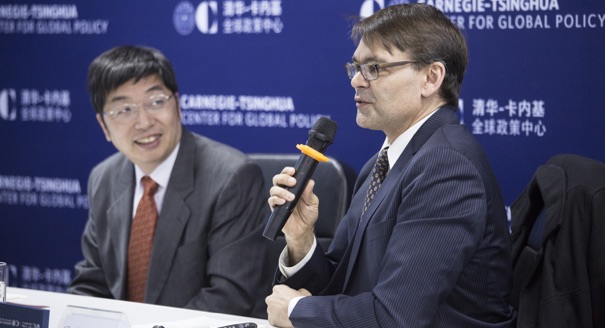Registration
You will receive an email confirming your registration.
The U.S. deployment of ballistic missile defense systems in the Asia-Pacific, including the Terminal High Altitude Area Defense (THAAD) system in South Korea, is seen as a central component of protection for forward-deployed U.S. forces and extended deterrence for allied security by leaders in Washington. In Beijing, however, these ballistic missile defense systems are thought to undermine regional stability and heighten security dilemmas. The 2017 National Defense Authorization Act indicated that the United States will continue to deploy increasingly advanced missile defense capabilities in Asia in the coming years. What measures should leaders take to improve international cooperation surrounding the deployment of missile defense systems?
In a discussion moderated by Li Bin, a senior fellow based at the Carnegie–Tsinghua Center, missile defense expert Charles Ferguson shared his views on what confidence building measures could help mitigate these systems’ potentially negative impact on stability in the Asia-Pacific region.
This event was off the record.
Discussion Highlights
- Shifting Strategic Dynamics: Russia and the United States have historically dominated the Asia-Pacific’s strategic landscape, but panelists argued that in a multi-polar global arena, the region will be affected by increasingly complex offensive and defensive dynamics. The ratcheting up of measures and countermeasures could lead to a cycle similar to that of an arms race, warned one panelist. The discussant added that with more players in the field, arms control will inevitably become increasingly complicated, with a greater likelihood for unanticipated and cross-domain effects.
- China’s Rationale for Strategic Ballistic Missile Deployment: The panelists discussed the findings of a 2015 Federation of American Scientists (FAS) study, which they described as outlining three likely reasons for China to deploy a strategic ballistic missile defense. The first would be to send a strategic message to India, Japan, and the United States that China is capable of defending itself. The second would be to obtain an understanding of ballistic missile defense systems for China’s own use, in addition to understanding how others systems operate. Finally, the panelists said China could deploy such a missile to enhance its regional prestige by demonstrating its mastery of a complex military technology.
- The Ballistic Missile Development Landscape in 2027: Expanding upon earlier China-focused research, a discussant described a current and ongoing FAS study that focuses on the ballistic missile development capabilities by 2027 for the United States, Russia, China, and India. The intention of the study, the panelist said, is to better understand the offensive and defensive dynamics within a multi-polar context. Once completed, the study is expected to provide an overview of each country’s technologies and policies, determine the characterization of factors affecting the multi-polar world of 2027 and the dynamics resulting from these factors, and explore the options for promoting stability.
- Tentative Study Findings: The FAS project is still in its early phase and has yet to reach firm conclusions, a discussant said, but early research has led to a few tentative findings. One such finding is that substantial increases in ballistic missile development could significantly impact other nuclear powers. Offensive capabilities are difficult to achieve for any state, the panelist said, which means that states will have to work hard to preserve them. Additionally, the panelist said that the study found that a leader may become less risk averse if offensive capabilities appear effective. The discussant concluded by saying that a limited ballistic missile defense could even potentially have a stabilizing effect, and China may change its nuclear posture in response to significant increases in U.S. ballistic missile development and regional tactical missile defense capabilities.
- Dialogue Needed to Ease THAAD Tensions: The deployment of the THAAD missile system has become a political and defense issue for China, one panelist said. Tensions are likely to increase in the future given that the United States and U.S. allies desire a defense and protection against North Korea, the discussant continued. China’s objection to THAAD, another panelist argued, is both political and technical. Politically, THAAD is connected to China’s history and worry about encirclement. Technically, China has concerns regarding the system’s true capabilities. One panelist said that the impetus for quickly pushing THAAD forward is an attempt to ready the launchers and radar systems prior to the inauguration of the next South Korean president. However, they said this expedited timeline is yet another reason for the need for a topical dialogue with China.
Li Bin
Li Bin is a senior fellow working jointly in the Nuclear Policy Program and Asia Program at the Carnegie–Tsinghua Center for Global Policy and a professor of Tsinghua University.
Charles Ferguson
Charles Ferguson is president of the Federation of American Scientists. He is an expert on energy policy, missile defense, nuclear proliferation, and nuclear terrorism.
